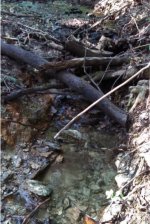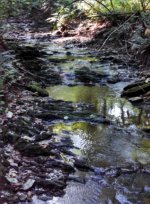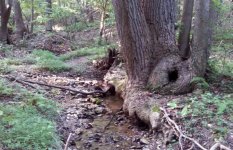You are using an out of date browser. It may not display this or other websites correctly.
You should upgrade or use an alternative browser.
You should upgrade or use an alternative browser.
Home Stream in Trouble
- Thread starter sarce
- Start date
FarmerDave
Well-known member
- Joined
- Dec 13, 2006
- Messages
- 14,257
Sarce, To me it sounds like there are multiple issues.
1. flooding and scouring issues,
2. The larger fish were fished out.
The dilemma is that more attention will help the one issue and hurt the other. Was the stream recently added to the reproduction list? It clearly has had more attention the last couple years.
The stream will only support so much biomass, and when the larger fish are removed from the best lies, the smaller ones (which are now the larger ones) move in.
If you don't think a small stream like that can't be negatively impacted by a single angler, you would be mistaken. Remove a limit or two and what do you have? I've done it myself to a similar stream in a similar setting 30 years ago.
Fortunately, this type of negative impact is short term impact. You can't catch them all and with less adults, more of the young will survive.
The flooding and scouring has a more long term impact, and it is probably good to bring to the attention of the local TU.
1. flooding and scouring issues,
2. The larger fish were fished out.
The dilemma is that more attention will help the one issue and hurt the other. Was the stream recently added to the reproduction list? It clearly has had more attention the last couple years.
The stream will only support so much biomass, and when the larger fish are removed from the best lies, the smaller ones (which are now the larger ones) move in.
If you don't think a small stream like that can't be negatively impacted by a single angler, you would be mistaken. Remove a limit or two and what do you have? I've done it myself to a similar stream in a similar setting 30 years ago.
Fortunately, this type of negative impact is short term impact. You can't catch them all and with less adults, more of the young will survive.
The flooding and scouring has a more long term impact, and it is probably good to bring to the attention of the local TU.
sarce
Well-known member
- Joined
- Feb 16, 2013
- Messages
- 1,504
FD,
The stream has been surveyed by PFBC but is not on the list yet, so that is not a reason. The pool below the dam does get fished by kids a lot, it's right next to the road. Aside from knowing that a few others fly fish there, I've seen no other evidence of fishing. I agree though that keeping a limit or two here would be damaging for a year. I don't know how easy it would be to catch that many though.
The stream has been surveyed by PFBC but is not on the list yet, so that is not a reason. The pool below the dam does get fished by kids a lot, it's right next to the road. Aside from knowing that a few others fly fish there, I've seen no other evidence of fishing. I agree though that keeping a limit or two here would be damaging for a year. I don't know how easy it would be to catch that many though.
FarmerDave
Well-known member
- Joined
- Dec 13, 2006
- Messages
- 14,257
sarce wrote:
FD,
The stream has been surveyed by PFBC but is not on the list yet, so that is not a reason.
Yea, I saw that right after I hit submit. But it was only a question. My argument still stands.
What are the odds that you would even fish it if not for your dad reading about it in the paper?
The stream I mentioned? I never saw another angler there, either.
If the issue were only erosion and silt, you would still some adult fish, but less YOY.
So, you tell me another reason why only the adults would be gone and the dinks have taken their place.
Publicity is sometimes good, sometimes bad, and sometimes both.
sarce
Well-known member
- Joined
- Feb 16, 2013
- Messages
- 1,504
If not for my dad reading about it, I probably would never have fished this stream or the half dozen other brookie streams nearby and probably would not be obsessed with wild trout the way I am today.
Your point does indeed still stand. I just haven't seen evidence of that, except in one pool.
My theory on why the adults are missing from some pools: some overhead tree root cover has been ripped out by floods, and/or the pools have gotten just a few inches shallower. Still plenty deep for young fish but not enough for big fish (but I think the big fish would be there if the overhead cover was there, even without making the pools deeper).
Another thing I just noticed the other day...There's a pond close to the stream that appears to have a leaky embankment. There is now about a foot-wide stream of water seeping through and entering the stream just below the section of pools that are missing trout. The water coming from this seep is very warm. maybe trout swimming upstream sense the warm water and do not pass through to the pools above? But the young trout are still up there...Just thinking out loud.
Your point does indeed still stand. I just haven't seen evidence of that, except in one pool.
My theory on why the adults are missing from some pools: some overhead tree root cover has been ripped out by floods, and/or the pools have gotten just a few inches shallower. Still plenty deep for young fish but not enough for big fish (but I think the big fish would be there if the overhead cover was there, even without making the pools deeper).
Another thing I just noticed the other day...There's a pond close to the stream that appears to have a leaky embankment. There is now about a foot-wide stream of water seeping through and entering the stream just below the section of pools that are missing trout. The water coming from this seep is very warm. maybe trout swimming upstream sense the warm water and do not pass through to the pools above? But the young trout are still up there...Just thinking out loud.
sarce
Well-known member
- Joined
- Feb 16, 2013
- Messages
- 1,504
Here are some more pics I took a few days ago. Les, if you see this, this is what is upstream of where we stopped (that you cannot see from the road).
Pool A is where I found one 8 inch brookie hiding under the large rock indicated by the arrow. I was able to net this fish for a quick photo as it tried to escape by running up and then down the riffle above the pool. It has unusually dark coloration for the stream but notice how fat and healthy it appears. The trout that are still here are certainly eating well.
Pool A used to hold anywhere from 3-5 6"+ brookies in the summer. I only saw this one plus a few YOY. The area I circled in red has filled in, it used to be nearly waist deep in the center of the pool and this is where the adult trout would lie. IIRC the pool got shallower and held less trout in 2009 or 2010.
Above this pool is the section I labeled "wide channel". erosion from floods is pretty obvious here. The tree roots at left were not exposed until a few years ago.
Continuing upstream are the pics labelled "potential" followed by "shallow run". "potential" used to have a deep plunge pool over the log that you can see in the middle. This was one of the first pools to disappear, it washed out in the 2007-2009 time frame. Hard to say exactly as I did not take pictures back then.
This area looks promising to me and should hold a few nice trout in the next year or two. The pool forming at bottom right is currently occupied by the YOY trout shown. This little pool did not exist two years ago and is on its way to being deep enough to hold an adult trout.
Above the log, there is a lot of brush/remnants of a log jam piled up over the left side of the creek which is starting to scour out a pool that will have excellent cover if the debris stays in place. I could not turn up any trout, yoy or adult, but there could easily be one hidden in there.
Upstream from there is the shallow run. Last year the tailout of this had a "stickjam" which produced a 6" brookie for me. A flood earlier this year washed it out and now there is not much to keep trout there. I did not turn up any. I placed a small log on the right bank as an idea of a kind of structure that would help here. I was thinking bury 2/3 of it in the gravel and the rest would stick out into the stream below the waterline. Scour could create some more depth and the log itself would serve as overhead cover.
Next up is "pool B". There used to be a 6-8" diameter log across the head of the pool and laying along the length of the pool in the water. While the log was there, 4-6 brookies over 6" long occupied the hole. The log got blown out and deposited on a bank downstream in 2011 IIRC. Since then, the pool has held 0-2 brookies over 6". There are currently none, but there are about 8-10 YOY. I also have a photo of this pool from 2011 and the tree that is knocked over laying across the head of the pool was still standing in the 2011 pic.
"Pool C" is next upstream. This is where I saw my first native brook trout in chester county back in 2005. At the time, there were 5 brookies over 6" here. Around 2009 there would only be 1 or 2 here. I have not seen any adult brookies in this pool since 2011, only some monstrous creek chubs and a few YOY brookies. The only changes here have been the loss of some small roots that used to extend into the water and the buildup of silt on the right bank. The other thing to notice is the stream of water coming in from the left. That is warm pond water seeping through the pond embankment. That little seep did not exist prior to 2010 and at that time it was just a wet area slowly dripping water over the left bank into the pool.
Upstream of here is a channelized section between the road and the pond that usually never held adult trout. every now and then a small logjam would form somewhere and a trout would move in, but never for more than a year or so. ABove this is a big bend pool followed by the pools above and below the small concrete dam. None of those three pools currently hold adult trout.
Pool A is where I found one 8 inch brookie hiding under the large rock indicated by the arrow. I was able to net this fish for a quick photo as it tried to escape by running up and then down the riffle above the pool. It has unusually dark coloration for the stream but notice how fat and healthy it appears. The trout that are still here are certainly eating well.
Pool A used to hold anywhere from 3-5 6"+ brookies in the summer. I only saw this one plus a few YOY. The area I circled in red has filled in, it used to be nearly waist deep in the center of the pool and this is where the adult trout would lie. IIRC the pool got shallower and held less trout in 2009 or 2010.
Above this pool is the section I labeled "wide channel". erosion from floods is pretty obvious here. The tree roots at left were not exposed until a few years ago.
Continuing upstream are the pics labelled "potential" followed by "shallow run". "potential" used to have a deep plunge pool over the log that you can see in the middle. This was one of the first pools to disappear, it washed out in the 2007-2009 time frame. Hard to say exactly as I did not take pictures back then.
This area looks promising to me and should hold a few nice trout in the next year or two. The pool forming at bottom right is currently occupied by the YOY trout shown. This little pool did not exist two years ago and is on its way to being deep enough to hold an adult trout.
Above the log, there is a lot of brush/remnants of a log jam piled up over the left side of the creek which is starting to scour out a pool that will have excellent cover if the debris stays in place. I could not turn up any trout, yoy or adult, but there could easily be one hidden in there.
Upstream from there is the shallow run. Last year the tailout of this had a "stickjam" which produced a 6" brookie for me. A flood earlier this year washed it out and now there is not much to keep trout there. I did not turn up any. I placed a small log on the right bank as an idea of a kind of structure that would help here. I was thinking bury 2/3 of it in the gravel and the rest would stick out into the stream below the waterline. Scour could create some more depth and the log itself would serve as overhead cover.
Next up is "pool B". There used to be a 6-8" diameter log across the head of the pool and laying along the length of the pool in the water. While the log was there, 4-6 brookies over 6" long occupied the hole. The log got blown out and deposited on a bank downstream in 2011 IIRC. Since then, the pool has held 0-2 brookies over 6". There are currently none, but there are about 8-10 YOY. I also have a photo of this pool from 2011 and the tree that is knocked over laying across the head of the pool was still standing in the 2011 pic.
"Pool C" is next upstream. This is where I saw my first native brook trout in chester county back in 2005. At the time, there were 5 brookies over 6" here. Around 2009 there would only be 1 or 2 here. I have not seen any adult brookies in this pool since 2011, only some monstrous creek chubs and a few YOY brookies. The only changes here have been the loss of some small roots that used to extend into the water and the buildup of silt on the right bank. The other thing to notice is the stream of water coming in from the left. That is warm pond water seeping through the pond embankment. That little seep did not exist prior to 2010 and at that time it was just a wet area slowly dripping water over the left bank into the pool.
Upstream of here is a channelized section between the road and the pond that usually never held adult trout. every now and then a small logjam would form somewhere and a trout would move in, but never for more than a year or so. ABove this is a big bend pool followed by the pools above and below the small concrete dam. None of those three pools currently hold adult trout.
Attachments
-
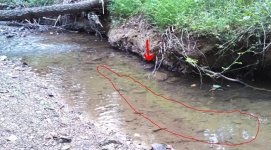 pool A.JPG146.4 KB · Views: 7
pool A.JPG146.4 KB · Views: 7 -
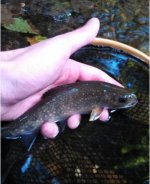 8.JPG35.6 KB · Views: 7
8.JPG35.6 KB · Views: 7 -
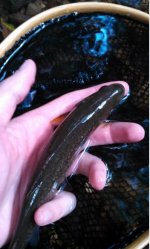 faint vermiculations.JPG43.4 KB · Views: 8
faint vermiculations.JPG43.4 KB · Views: 8 -
 wide streambed.JPG134.7 KB · Views: 5
wide streambed.JPG134.7 KB · Views: 5 -
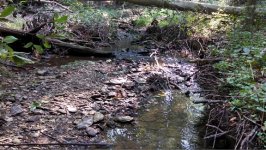 potential.JPG142.7 KB · Views: 7
potential.JPG142.7 KB · Views: 7 -
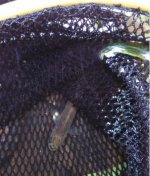 YOY.JPG42.3 KB · Views: 6
YOY.JPG42.3 KB · Views: 6 -
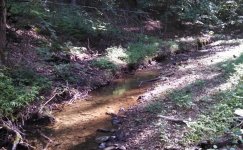 shallow run.JPG144.5 KB · Views: 7
shallow run.JPG144.5 KB · Views: 7 -
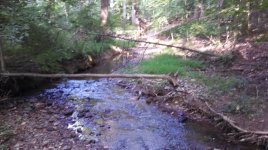 pool B.JPG138.2 KB · Views: 8
pool B.JPG138.2 KB · Views: 8 -
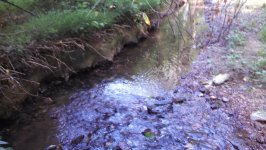 pool B close-up.JPG145.4 KB · Views: 6
pool B close-up.JPG145.4 KB · Views: 6 -
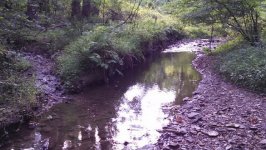 pool C.JPG134 KB · Views: 7
pool C.JPG134 KB · Views: 7 -
 creek chubs.JPG54 KB · Views: 7
creek chubs.JPG54 KB · Views: 7 -
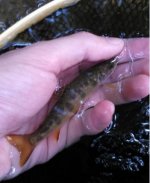 big YOY.JPG29.5 KB · Views: 6
big YOY.JPG29.5 KB · Views: 6
Who owns the floodplain land, and the surrounding land?
What is their present use of the land? And what do you think is likely to be the future ownership and usage of the land?
These questions haven't even been discussed. But they are the most important questions when it comes to stream conservation.
What is their present use of the land? And what do you think is likely to be the future ownership and usage of the land?
These questions haven't even been discussed. But they are the most important questions when it comes to stream conservation.
sarce
Well-known member
- Joined
- Feb 16, 2013
- Messages
- 1,504
Housing developments own almost all of the floodplain and surrounding land. I expect it to remain that way for a long time. there is no room left to build more houses, the land is too steep.
The area with the pond used to be a Boy Scout camp. There are mountain biking trails through the woods that people continue to use. The road is used by local residents for walking dogs, jogging, biking, and riding ATVs and dirtbikes.
The area with the pond used to be a Boy Scout camp. There are mountain biking trails through the woods that people continue to use. The road is used by local residents for walking dogs, jogging, biking, and riding ATVs and dirtbikes.
FarmerDave
Well-known member
- Joined
- Dec 13, 2006
- Messages
- 14,257
Definitely looks like it had some flooding. It looks a little bit like the stream flowing through my property only it pretty much dries up in the summer. Not this summer of course. Other times it is a raging.
Studies showed that some of these little streams around me could hold trout, but they all have some silt issues from all of the farming and flow into slow moving carp water that I swear approaches flood stage on humid days. (slight exaggeration again).
Your stream could definitely use some stabilization. Then again, it could straighten itself out. Mother nature has done some of the best stream improvements projects that I have ever seen.
Good that no new development will be going on. The more recent construction likely added to the effect if they aren't handling the additional storm runoff properly ... what Chaz said earlier.
Studies showed that some of these little streams around me could hold trout, but they all have some silt issues from all of the farming and flow into slow moving carp water that I swear approaches flood stage on humid days. (slight exaggeration again).
Your stream could definitely use some stabilization. Then again, it could straighten itself out. Mother nature has done some of the best stream improvements projects that I have ever seen.
Good that no new development will be going on. The more recent construction likely added to the effect if they aren't handling the additional storm runoff properly ... what Chaz said earlier.
In your photos, I don't see any large woody debris.
Why isn't there more of that? Is there something in the past and/or current stream/floodplain management that is preventing that?
In that type of stream the normal situation is that large woody debris is involved in much of the formation of pools and cover.
Why isn't there more of that? Is there something in the past and/or current stream/floodplain management that is preventing that?
In that type of stream the normal situation is that large woody debris is involved in much of the formation of pools and cover.
FDave: What else would remove most adults (and what is more likely to do so in Pa ST streams)? Weak year class (or classes) four to five years prior. That is even more true in streams that get "ripped" by stormwater. Growth rates of fish in the next good year class can be enhanced by the lack of competition. If there is fair to good adult habitat, very good numbers of seven to eight inch, as well as occasional nine inchers can appear, but these ripped streams seldom have an abundance of such habitat.
Troutbert: Large woody debris are uncommon in SE Pa small trout streams. Such debris are accounted for in a category of the index of biotic integrity records from each sampling site, and I can tell you that they rarely contribute to the index in the SE. Our riparian trees are generally species that are deeply rooted or do not easily shed large branches. Where we have hemlock it is a different story.
Troutbert: Large woody debris are uncommon in SE Pa small trout streams. Such debris are accounted for in a category of the index of biotic integrity records from each sampling site, and I can tell you that they rarely contribute to the index in the SE. Our riparian trees are generally species that are deeply rooted or do not easily shed large branches. Where we have hemlock it is a different story.
Mike wrote:
Troutbert: Large woody debris are uncommon in SE Pa small trout streams.
That's the problem. The natural condition is large amounts of LWD.
The LWD amounts are low now because of past management practices. And that explains much of what's shown in those photos. With normal amounts of LWD the stream structure would be totally different.
LWD amounts can be built up again by good management practices.
sarce
Well-known member
- Joined
- Feb 16, 2013
- Messages
- 1,504
The watershed is heavily forested along the creek and steep valley slopes with houses on the ridge tops and some hillsides. Most LWD that ends up in the stream gets blasted up onto the bank by floods, so during low water the logs that could make great habitat are perched 2-3 feet higher than the water level.
Mike, do you think that holds true (bad year class/growth rates) even when the trout have always grown pretty large for the size of the stream here? I can't think of a year that I failed to catch a 10" brookie here. my best was 11" in 2010. Didn't seem to matter how many adult fish there were, they always got big and fat by freestone brookie standards. After two years in the stream they reach about 6.5-7.5". Everything you said makes sense but I think if it was a bad year class it would be the one about 3 years ago. And for about 4 years in a row, the upper part of the stream has seemed to have lost nearly all of the adult brookies, while the lower half had good numbers of 7-9" fish in 2012 and has not come close in 2013 or this year.
I explored far up a tributary today that somehow, in all my years fishing here, I never checked out more than about 100 ft up from the mouth. It is a trickle that shows signs of a massive stormwater blowout problem. I did find about a dozen YOY brookies scattered all the way up to the very headwaters where the deep pools were about a foot wide, 2' long, and 3 inches deep. Pics to come tomorrow when I have time to upload them.
Mike, do you think that holds true (bad year class/growth rates) even when the trout have always grown pretty large for the size of the stream here? I can't think of a year that I failed to catch a 10" brookie here. my best was 11" in 2010. Didn't seem to matter how many adult fish there were, they always got big and fat by freestone brookie standards. After two years in the stream they reach about 6.5-7.5". Everything you said makes sense but I think if it was a bad year class it would be the one about 3 years ago. And for about 4 years in a row, the upper part of the stream has seemed to have lost nearly all of the adult brookies, while the lower half had good numbers of 7-9" fish in 2012 and has not come close in 2013 or this year.
I explored far up a tributary today that somehow, in all my years fishing here, I never checked out more than about 100 ft up from the mouth. It is a trickle that shows signs of a massive stormwater blowout problem. I did find about a dozen YOY brookies scattered all the way up to the very headwaters where the deep pools were about a foot wide, 2' long, and 3 inches deep. Pics to come tomorrow when I have time to upload them.
FarmerDave
Well-known member
- Joined
- Dec 13, 2006
- Messages
- 14,257
Mike wrote:
FDave: What else would remove most adults (and what is more likely to do so in Pa ST streams)? Weak year class (or classes) four to five years prior. That is even more true in streams that get "ripped" by stormwater. Growth rates of fish in the next good year class can be enhanced by the lack of competition. If there is fair to good adult habitat, very good numbers of seven to eight inch, as well as occasional nine inchers can appear, but these ripped streams seldom have an abundance of such habitat.
That makes sense and the stream definitely does show sings of being "ripped."
I'd still think there would be larger numbers of 7 to 9 inch fish, but with all the undercuts, they could be there.
Extracted from the draft report (2012 survey):
The instream habitat was comprised of short to long, shallow riffles, pocket pools, and long pools at bends up to 0.5 m in depth. Cover was provided by undercut tree roots and pool depth. The stream substrate consisted primarily of cobble, gravel, and sand with some bedrock and boulder. The stream suffers from high stormwater flows which have caused heavy bank erosion. The RBP analysis yielded a relatively low final score of 119, indicating sub-optimal habitat conditions.
The presence of multiple year classes of wild brook trout in the UNT , including young-of-the-year, verifies that this stream supports the natural reproduction of trout as outlined in Pennsylvania Code, Title 58, Chapter 57, Subchapter A, §57.11. The abundance of legal-size brook trout (80 trout/mi) was between the 75th and 90th percentiles for legal size brook trout in Pennsylvania’s wild brook trout streams.
The instream habitat was comprised of short to long, shallow riffles, pocket pools, and long pools at bends up to 0.5 m in depth. Cover was provided by undercut tree roots and pool depth. The stream substrate consisted primarily of cobble, gravel, and sand with some bedrock and boulder. The stream suffers from high stormwater flows which have caused heavy bank erosion. The RBP analysis yielded a relatively low final score of 119, indicating sub-optimal habitat conditions.
The presence of multiple year classes of wild brook trout in the UNT , including young-of-the-year, verifies that this stream supports the natural reproduction of trout as outlined in Pennsylvania Code, Title 58, Chapter 57, Subchapter A, §57.11. The abundance of legal-size brook trout (80 trout/mi) was between the 75th and 90th percentiles for legal size brook trout in Pennsylvania’s wild brook trout streams.
sarce
Well-known member
- Joined
- Feb 16, 2013
- Messages
- 1,504
Thanks Mike! good info and the habitat analysis is spot-on. However I disagree that there are 80 legal size trout per mile, not in the past two years anyway. If that is based on surveying part of the stream and making an estimate based on that, I can see how that number could make sense. It may not have covered the sections that are channelized along the road with very few adult trout. And in 2012, the number in the lower mile or so (below the last road crossing) was significantly higher than what it has been the past two years.
If they did survey the entire length of stream and found 80/mi...then I am just not very good at spooking fish!!
If they did survey the entire length of stream and found 80/mi...then I am just not very good at spooking fish!!
sarce
Well-known member
- Joined
- Feb 16, 2013
- Messages
- 1,504
Here are a few pics of the tributary I explored yesterday. It looks like the runoff cut a channel along an old sewer line (old=no longer used). The headwaters of the trib start in that channel but then seep through to the natural channel which is lower elevation and parallels it. So the storm runoff is confined to the unnatural channel along the old sewer line, and it seems this is actually protecting the natural channel of the tributary. However, the main creek still gets hit with all of that runoff (and this is downstream of the last set of pictures I posted, so you can imagine the combined runoff effect is worse below this tributary).
I found YOY brookies and dace all the way up, some 4" long. The was one in the pool in "trib1a" and two in 1c.
I found YOY brookies and dace all the way up, some 4" long. The was one in the pool in "trib1a" and two in 1c.
Attachments
sarce wrote:
It may not have covered the sections that are channelized along the road with very few adult trout.
Another impact revealed. A very common, and often severe one.
But there are ways of dealing with impact of the road and related channelization.
Roads can be relocated out of the floodplain. And the current road grade removed, and colonized with vegetation.
sarce
Well-known member
- Joined
- Feb 16, 2013
- Messages
- 1,504
That would be ideal but not practical here. there's nowhere to move the road to. And it would cost a ton of money compared to the smaller-scale stuff that could prove just as beneficial. It could be possible to move the stream away from the road in a few places...would take a lot of work but it's doable. IMO some artificial plunge pools are the short-term answer in the channelized areas.
sarce
Well-known member
- Joined
- Feb 16, 2013
- Messages
- 1,504
I was home this past weekend and got to spend a few minutes walking the creek while running errands. Walked about 200 yds, did not see any obvious redds or adult fish but I didn't have time to check out some better areas. I also don't know when these fish spawn. Typically i havent been home at that time of year to check it out. Could have spawned weeks ago.
Did see some YOY and one appeared to be approaching 5" in length. There were definitely fewer than this summer but I am assuming that's natural as they grow and compete with each other.
Fingers crossed that there are no major floods this winter. If there are none it will be interesting to see how much the population bounces back next year.
Did see some YOY and one appeared to be approaching 5" in length. There were definitely fewer than this summer but I am assuming that's natural as they grow and compete with each other.
Fingers crossed that there are no major floods this winter. If there are none it will be interesting to see how much the population bounces back next year.

